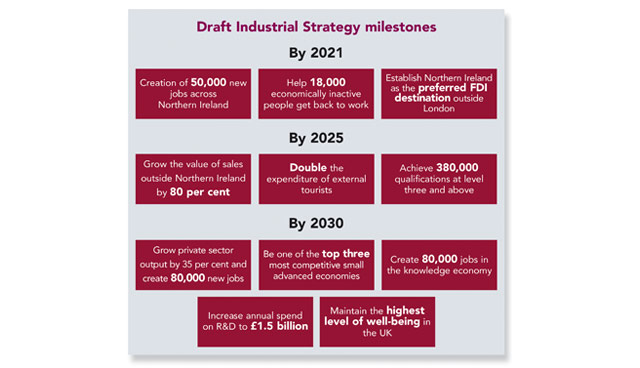Draft Industrial Strategy

In January 2017, the draft Industrial Strategy was published by former Economy Minister Simon Hamilton as a successor to the previous Economic Strategy which had been launched in 2012. agendaNi reflects on its proposals.
The Department described Economy 2030 as “an ambitious, long term vision to transform Northern Ireland into a globally competitive economy that works for everyone”, the rationale being for the strategy to establish a long-term vision, a sense of purpose and direction for the Northern Ireland economy and a prioritisation of effort.
Speaking at the launch, then Minister Simon Hamilton outlined his ambition to position Northern Ireland as “one of the world’s most innovative and competitive small advanced economies” and suggested that Northern Ireland could “once again become an economic powerhouse”. The draft strategy and subsequent delivery of the vision is centred on five priority pillars for growth. A core focus of the draft strategy is increasing economic competitiveness to drive export-led growth. The report acknowledges that Northern Ireland’s productivity, a key indicator of competitiveness, is well below the UK average, which is itself below the international average. The success of other world-leading, small advanced economies is the benchmark established for Northern Ireland.
The strategy also identifies “historically high levels of economic inactivity” as evidence of limited economic prospect and socio-economic disadvantage. Balanced regional growth which addresses poverty and social exclusion is targeted through the facilitation of access to the labour market and skill support. The draft states that, “the Industrial Strategy is not just about building a better economy, but is about securing benefits for everyone… We want economic growth, not for growth’s sake, but for the common good”.The Industrial Strategy is intended to reinforce outcomes in the draft Programme for Government and complement both the Investment Strategy and the Social Strategy in order to enable prioritisation of the budget. All supplementary strategies and economic development policies are aligned with the five pillars for growth.
There is a recognition that small economies “cannot be experts or world class in every area”. Therefore, while each sector will be supported, those which will receive prioritisation are the sectors and subsectors which are already deemed to be world class or hold the potential to be world class, for example in advanced manufacturing and service sectors. “We need to concentrate on sectors and niches with world class potential,” asserts the draft Strategy.
Twinned with an emphasis on competitiveness is inclusiveness. The draft outlines: “Only by government working alongside the wider public sector, the voluntary and community sector, trade unions and business will we be able to realise our vision of strong and sustainable growth which works for everyone.” As such, an Industrial Strategy Partnership comprising these stakeholders is mooted to advise on and assist in the implementation of the strategy. Progress, which is aligned with draft Programme for Government indicators, is to be measured against a number of key economic milestones.
In June, Sinn Féin’s Conor Murphy criticised the draft Industrial Strategy for failing to address shortcomings of the previous Economic Strategy which “led to the lowest rate of economic growth in these islands”. Murphy’s contention is that unless mistakes are not admitted and reflected upon, lessons will not be learned.
While industrial policy is now undergoing something of a resurgence relative to enterprise policy, Murphy goes on to censure Hamilton’s draft Strategy for “applying a standard set of enterprise policies, described as five ‘pillars for growth’” rather than providing programmes tailored to the needs of each industry.
Five pillars for growth
- Accelerating innovation and research
- Enhancing education, skills and employability
- Driving inclusive, sustainable growth
- Succeeding in global markets
- Building the best economic infrastructure
Overall, Murphy suggests that the industrial strategy lacks “rigour and an attention to detail” and asserts that while the DUP “talked the language of the business community” during its decade in control, “underneath the spin and the swagger, the North’s economy continued to underperform”. Concluding, he argues: “When the Executive is restored, a radical improvement in the Industrial Strategy will be required.”
In response, the DUP’s Simon Hamilton emphasises his pride that “our policies have helped to produce the lowest unemployment levels in our history, an all-time high in research and development investment and record numbers of overseas visitors”. He also recalls that it was welcomed “by a number of organisations ranging from business organisations to trade unions”. Conceding that the draft Industrial Strategy was not “the perfect document”, Hamilton underscores both its ambitious nature and the fact that it is a mere draft. He reiterates the stated objective of focusing energy on particular sectors which are simultaneously synced with academic fields within which the local third-level institutions have “international capability in terms of research”. In his concluding statement, the former Economy Minister notes: “The DUP will join Sinn Féin in power sharing and begin taking those big decisions, including finalising an ambitious industrial strategy, that will improve lives and move Northern Ireland forward.”






